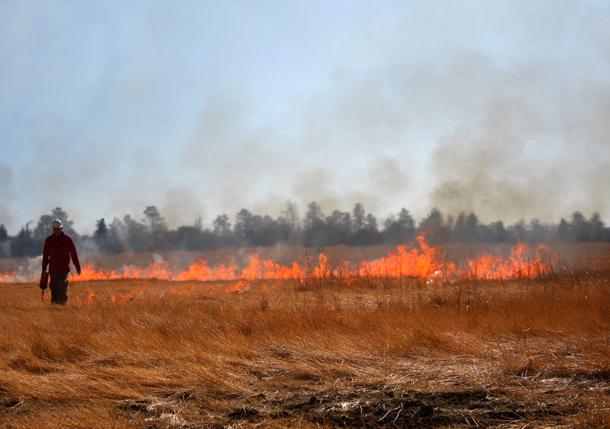California must learn to fight fire with prescribed fire, experts say
A firefighter uses a drip torch as part of a prescribed burn in the Coconino National Forest, Arizona. Controlled burning removes grasses, small undergrowth, fallen trees and branches and other dry matter that can turn natural fires into raging infernos.
The huge wildfires in California have their roots in small things: the abundance of underbrush that, from a single spark, can ignite a whole forest.
Natural fires, often caused by lightning, can be beneficial for forests so long as they happen often enough to clear tinder that can feed a firestorm. One proven way of preventing wildfires is the use of prescribed fire, not unlike what Native Americans historically did to manage the landscape and attract game.
Related: California fires are the ‘extinction of whole habitats’
But prescribed burns are barely used in California, where hundreds of thousands of people have had to evacuate their homes recently as perfect conditions fueled the Kincade and other fires. Just over 2% of prescribed burns in the US are done in California, according to a paper published in the May 2019 issue of Fire, a peer-reviewed journal.
“Where we’re doing prescribed fire for forest health, we’re actually trying to remove a lot of those competitors and allow the big trees to soak up more water and more nutrients and grow even bigger and healthier.”
“If we’re doing prescribed fires to reduce wildfire risk, the little stuff seems really harmless but that’s what carries a fire and allows it to start really building energy and getting up into the crowns of the trees,” explained the study’s lead author, Crystal Kolden, a pyrogeographer at the University of Idaho. “Where we’re doing prescribed fire for forest health, we’re actually trying to remove a lot of those competitors and allow the big trees to soak up more water and more nutrients and grow even bigger and healthier.”
As an added benefit, the bigger the trees, the more carbon they remove from the atmosphere, Kolden added.
The “suppression mantra” in the western US gained momentum during the 1940s, Kolden said. A number of things happened simultaneously to bring this on. First, some large fires in the western US destroyed a lot of valuable timber, prompting calls to suppress fires in order to save the timber. Smokey Bear comes from this era.
Related: Amazon fires push forest closer to a dangerous tipping point
In addition, historical materials from World War II indicate the US government drew a link between the Axis powers — particularly the Germans and the Japanese — and forest fires, Kolden explains. The government spread the message that if you set forest fires, you’re actually helping the enemy. “It was very ‘American’ at the time to suppress those fires,” she said.
By contrast, the southeastern US has a different history and land-use legacy than the western US, as well as a different climate, Kolden said.
The states in the region started to build prescribed fire programs in the Southeast in the 1920s and 30s primarily as a way of preserving game species that hunters noticed were disappearing. Several biologists and wildlife ecologists wondered if a fire could help restore the habitats of these birds — and in fact, it did.
Related: California megafires are common due to climate change
“So, there was an evolution away from the suppression mindset and toward the idea that fire can actually be really beneficial — beneficial for the game species that they like to hunt, but also beneficial for the forests that form an economic component in the Southeast, these longleaf pine forests,” Kolden explains. Today, the Southeast burns about 5 million acres a year — over 70% of prescribed fire in the US.
In California, neighborhood burn squads are starting to take prescribed fire into their own hands, partly as a result of California Bill 1260 which is intended to increase the amount of prescribed fire in the state by developing an educational curriculum that trains citizens how to use prescribed fire and set up a permit program.
Kolden said she is interested in watching how this develops. In California, about 45% of land is privately owned. Federal fire managers can only do prescribed burns on federal lands, which means a lot of land that could benefit from prescribed fire won’t get it from the federal fire professionals, because it’s not their jurisdiction and because they don’t have enough people and resources to do it.
The other huge challenge in fire-prone areas is trying to build houses that are more fireproof, Kolden said. In many of the communities impacted by fires, the houses were built during an era when there was not as much fire, so they were not built to be less flammable. Instead, they were built to be less prone to damage from earthquakes. Many of these homes are made of wood, not brick, because brick houses don’t survive earthquakes very well, Kolden explained.
Metal or asphalt shingle roofs, exteriors made from stucco or fiber cement siding instead of wood, eliminating openings in the house that allow burning embers to get in, clearing underbrush away from the exterior of the house — all of these measures could save people’s homes. But these types of conversions are expensive and, despite the danger, many homeowners resist the changes, either for aesthetic reasons or because they simply can’t afford them.
“This has been a real challenge, to try and convince people to build houses that are more fire-resistant,” Kolden said.
This article is based on an interview that aired on PRI’s Living on Earth with Steve Curwood.
Our coverage reaches millions each week, but only a small fraction of listeners contribute to sustain our program. We still need 224 more people to donate $100 or $10/monthly to unlock our $67,000 match. Will you help us get there today?
